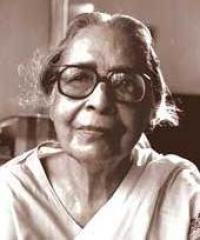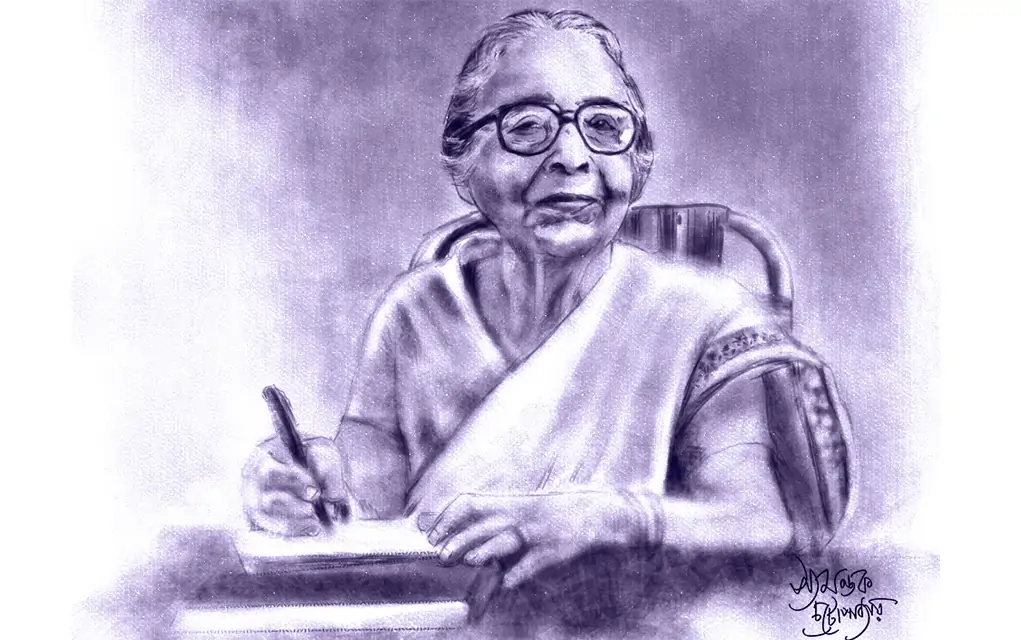Leela Majumdar (Lila Mojumdar), born on February 26, 1908, to Surama Devi and Pramada Tanjan Ray, was one of Bengal’s renaissance women. She was an author, teacher, art critic, and most of all, a feminist who was ahead of her times. The Bengals Renaissance is a cultural, social, intellectual, and artistic movement that was later taken over by patriarchy.
However, born with a brilliant mind, Leela Majumdar was an author who could cast spells with her words and characters. She made a name for herself in Bengal’s literary landscape. She had a cheerful spirit and always wished to spread that joy among her children and students. Carrying the same energy, she gave life to so many characters that always leave her readers stunned.
Leela Majumdar speeded into the reader’s consciousness with her well-written, and authentic characters like Panu, Napo, and others. Throughout her life, she wanted children to develop the ability to see the world through a lens that spoke of magic, wonders, and fantasy. She was a writer who wanted her readers to be pulled into the narratives she created, and with her joyousness and a spirit full of youthful wonder, she accomplished that and so much more.

Leela Majumdar spent her childhood in Shillong, where she studied at the Loreto Convent. She ranked second among all the girls in St. John’s Diocesan School in the matriculation examinations in 1924. True to her work as a writer, she was placed first in English Literature both in her honours graduation and at the University of Calcutta. It is widely known that Leela Majumdar, along with the Ray Chaudhuri family, laid the foundation for children’s literature in Bengali.
During her early career, she worked as a teacher in multiple schools before she discontinued and began writing. She had been writing ever since then and spent most of her time as a writer. After years of writing, she joined the All India Radio as a producer and worked there for almost eight years.
Her career in writing began when she published her first story Lakkhi Chhele in the magazine Sandesh along with her uncle Upendrakishore Ray Chaudhuri in 1922. Following this, she edited and wrote for the magazine throughout her writing career.
Boddi Nather Bari was the first book published by her, soon following with Din Dupure. It was through her second book that she received fame and recognition as an author. She was known for writing with humour, but she explored other areas of the literary world like detective fiction, fantasies, and so on.
Din Dupure is Leela Majumdar’s second published book, and this book brought her considerable fame in the 1950s. Din Dupure is a collection of short stories written for children. The stories explore themes of family relationships, thievery and much more. Although Din Dupure is a children’s book, Leela Majumdar’s books do not have an age bar
Pakdandi and Aar Konokhane
Leela Majumdar had a strong personality but she never imposed her values on others. Her autobiographical books like Pakdandi and Aar Konokhane, give a glimpse into her childhood days in Shillong and her career with All India Radio. She wrote a variety of novels other than her contribution to children’s literature.
She wrote books ranging from cookbooks, the biography of Rabindranath Tagore, to novels like Cheena Lanthan. She also translated Abanindranath Tagore’s writings on art, Jonathan Swift’s Gulliver’s Travels, and Ernest Hemingway’s The Old Man and the Sea into both Bengali and English.
Her autobiographical sketches are acclaimed for their literary merit and for the rawness and realness with which she delivers her stories. She treated her readers at par and always communicated with them honestly. The frankness and style of her narratives are difficult to acquire, but they are also what made her stand out as an author.
She had immense trust in her readers, and the readers had faith in her work as well. In her autobiographies, Leela Majumdar has talked about how she refused to marry a groom selected by her parents and her unconventional marriage. Leela Majumdar was married to a renowned dentist Dr. Sudhir Kumar Majumdar in 1933. The inter-caste marriage had led to a struggle between her and her father. Majumdar’s father had refused to keep in touch with her, but she had still not budged.
Also read: Lila Majumdar: Bengal’s Beloved Storyteller | #IndianWomenInHistory
![Lila Majumdar: A Granddaughter Remembers -- Interview of Srilata Banerjee by Anu Kumar [Parabaas Reviews]](https://www.parabaas.com/translation/database/authors/images//lilamajumdar_pic2.jpg)
Din Dupure
Din Dupure is Leela Majumdar’s second published book, and this book brought her considerable fame in the 1950s. Din Dupure is a collection of short stories written for children. The stories explore themes of family relationships, thievery and much more. Although Din Dupure is a children’s book, Leela Majumdar’s books do not have an age bar.
People from across age groups read and enjoy her book. Diversified aspects of Bengali children’s literature have been explored in this book. Din Dupure contains stories that are humorous and joyful in nature.
The Yellow Bird
The Yellow Bird was translated from Bengali by Kamala Chatterjee. It is a story about a mystical and bizarre bird. When the bird makes an appearance, all the other animals turn into human beings or behave in erratic ways. Jhogru is the narrator of the story, who works for Rumu and Bogey, helping them with a variety of domestic activities.
One day, a street dog called Bhulo disappears and goes missing for a long time. Children’s emotions are usually shrugged off or not acknowledged with the sincerity that they deserve. However, Jhogru empathises with them and helps them cope with the loss of their beloved dog.
Through a series of magical and unforgettable stories and narration, Jhogru tries to help the children. He never seems to run out of stories, and the fantasy world keeps the children occupied and free of worry for a long time. Does the dog return? Does Jhogru run out of stories? The Yellow Bird is a great book to widen the imaginations of children, introduce them to the world of magic, and inculcate meaningful values.
Leela Majumdar has won many awards for her work in children’s literature. Bak Badh Pala, a Bengali drama created by Majumdar won the Sangeet Natak Akademi Award from the Government of India in 1963. A documentary film called “Peristan – The World of Lila Majumdar” was also made about her. As an extension of her writing, she also had spells to make great food. She was a great cook and wrote cookbooks where she introduced the technique of presenting the preparation of dishes along with stories and tales of the associated culture
The Burmese Box (Two Novellas)
The Burmese Box: Two Novellas was translated from Bengali by Srilata Banerjee. The Burmese Box has themes of mystery, fun, and excitement. It is a story about how Goopy decided to find the most-treasured Burmese Box that was a part of family history. It is an action-packed story, following the adventures of Goopy and his family on a treasure hunt, how they grapple with difficulties, question suspicious characters, and handle eccentric relatives.
The book features two novellas, and both the stories are loved by the children and iare also known to be famous amongst the adults. Her impeccable style and humour keeps the readers engaged and asking for more.

Leela Majumdar’s enthralling characters
Leela Majumdar created a character called Manimala for a special Mahila Mahal series. Majumdar’s views of feminism and equality were painted in the story of Manimala. It was not a surprise that the entire concept of generation gap did not exist when it came to Majumdar, because she was way ahead of her time. Manimala was a true reflection of Majumdar’s own self and personality.
“Please remember her as a happy woman, who wanted to spread joyousness and the spirit of wonder that is found in children. That’s what she wanted, till the last day of her life – the ability that all children have of seeing the world around them as something magical and beautiful, full of light and happiness in which even the inevitable sorrows and ugliness dissolve and are washed away,” wrote Srilata Banerjee, Majumdar’s granddaughter.
Leela Majumdar has won many awards for her work in children’s literature. Bak Badh Pala, a Bengali drama created by Majumdar won the Sangeet Natak Akademi Award from the Government of India in 1963. A documentary film called “Peristan – The World of Lila Majumdar” was also made about her. As an extension of her writing, she also had spells to make great food. She was a great cook and wrote cookbooks where she introduced the technique of presenting the preparation of dishes along with stories and tales of the associated culture.
Leela Majumdar was a sensation in everything she did, and she believed that women have equal importance in society. She stitched literature with the art of cooking, and revealed secrets, questioned stereotypes and beliefs, and brought out the beauty of community life along the way.
Also read: K Saraswathi Amma: The Pioneer Of Feminist Literature In Malayalam
Featured Image Source: BanglaLive
About the author(s)
Prathyusha [they/them] is a queer writer from Chennai. When they are not reading, they are either baking or buying books




